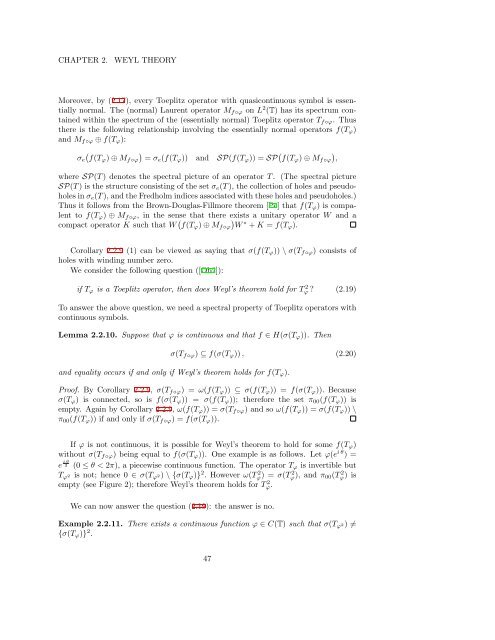Woo Young Lee Lecture Notes on Operator Theory
Woo Young Lee Lecture Notes on Operator Theory
Woo Young Lee Lecture Notes on Operator Theory
You also want an ePaper? Increase the reach of your titles
YUMPU automatically turns print PDFs into web optimized ePapers that Google loves.
CHAPTER 2.<br />
WEYL THEORY<br />
Moreover, by (2.17), every Toeplitz operator with quasic<strong>on</strong>tinuous symbol is essentially<br />
normal. The (normal) Laurent operator M f◦φ <strong>on</strong> L 2 (T) has its spectrum c<strong>on</strong>tained<br />
within the spectrum of the (essentially normal) Toeplitz operator T f◦φ . Thus<br />
there is the following relati<strong>on</strong>ship involving the essentially normal operators f(T φ )<br />
and M f◦φ ⊕ f(T φ ):<br />
σ e<br />
(<br />
f(Tφ ) ⊕ M f◦φ<br />
)<br />
= σe (f(T φ )) and SP(f(T φ )) = SP ( f(T φ ) ⊕ M f◦φ<br />
)<br />
,<br />
where SP(T ) denotes the spectral picture of an operator T . (The spectral picture<br />
SP(T ) is the structure c<strong>on</strong>sisting of the set σ e (T ), the collecti<strong>on</strong> of holes and pseudoholes<br />
in σ e (T ), and the Fredholm indices associated with these holes and pseudoholes.)<br />
Thus it follows from the Brown-Douglas-Fillmore theorem [Pe] that f(T φ ) is compalent<br />
to f(T φ ) ⊕ M f◦φ , in the sense that there exists a unitary operator W and a<br />
compact operator K such that W ( f(T φ ) ⊕ M f◦φ<br />
)<br />
W ∗ + K = f(T φ ).<br />
Corollary 2.2.9 (1) can be viewed as saying that σ(f(T φ )) \ σ(T f◦φ ) c<strong>on</strong>sists of<br />
holes with winding number zero.<br />
We c<strong>on</strong>sider the following questi<strong>on</strong> ([Ob2]):<br />
if T φ is a Toeplitz operator, then does Weyl’s theorem hold for T 2 φ (2.19)<br />
To answer the above questi<strong>on</strong>, we need a spectral property of Toeplitz operators with<br />
c<strong>on</strong>tinuous symbols.<br />
Lemma 2.2.10. Suppose that φ is c<strong>on</strong>tinuous and that f ∈ H(σ(T φ )). Then<br />
σ(T f◦φ ) ⊆ f(σ(T φ )) , (2.20)<br />
and equality occurs if and <strong>on</strong>ly if Weyl’s theorem holds for f(T φ ).<br />
Proof. By Corollary 2.2.9, σ(T f◦φ ) = ω(f(T φ )) ⊆ σ(f(T φ )) = f(σ(T φ )). Because<br />
σ(T φ ) is c<strong>on</strong>nected, so is f(σ(T φ )) = σ(f(T φ )); therefore the set π 00 (f(T φ )) is<br />
empty. Again by Corollary 2.2.9, ω(f(T φ )) = σ(T f◦φ ) and so ω(f(T φ )) = σ(f(T φ )) \<br />
π 00 (f(T φ )) if and <strong>on</strong>ly if σ(T f◦φ ) = f(σ(T φ )).<br />
If φ is not c<strong>on</strong>tinuous, it is possible for Weyl’s theorem to hold for some f(T φ )<br />
without σ(T f◦φ ) being equal to f(σ(T φ )). One example is as follows. Let φ(e i θ ) =<br />
e i θ<br />
3 (0 ≤ θ < 2π), a piecewise c<strong>on</strong>tinuous functi<strong>on</strong>. The operator T φ is invertible but<br />
T φ 2 is not; hence 0 ∈ σ(T φ 2) \ {σ(T φ )} 2 . However ω(Tφ) 2 = σ(Tφ), 2 and π 00 (Tφ) 2 is<br />
empty (see Figure 2); therefore Weyl’s theorem holds for Tφ.<br />
2<br />
We can now answer the questi<strong>on</strong> (2.19): the answer is no.<br />
Example 2.2.11. There exists a c<strong>on</strong>tinuous functi<strong>on</strong> φ ∈ C(T) such that σ(T φ 2) ≠<br />
{σ(T φ )} 2 .<br />
47













